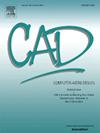Computational design and fabrication of reusable multi-tangent bar structures
IF 3.1
3区 计算机科学
Q2 COMPUTER SCIENCE, SOFTWARE ENGINEERING
引用次数: 0
Abstract
Temporary bar structures made of reusable standardized components are widely used in construction, events, and exhibitions. They are economical, easy to assemble, and can be disassembled and reused in various structural arrangements for various purposes. However, existing reusable temporary structures are either limited to modular yet repetitive designs or require bespoke components, which restricts their reuse potential. Instead of designing bespoke kit of parts for limited reuse, this paper investigates how to design and build diverse freeform structures from one homogeneous kit of parts. We propose a computational framework to generate multi-tangent bar structures, a widely used jointing system, which allows bars to be joined at any point along their length with standard connectors. We present a mathematical formulation and a numerical scheme to optimize the bar spatial positions and contact assignment simultaneously, while ensuring that the constraints of tangency, collision, joint connectivity, and bar length are satisfied. Together with simulated case studies, we present two physical prototypes that reuse the same kit of parts using an augmented reality-guided assembly workflow.
可重复使用多切线杆结构的计算设计与制造
由可重复使用的标准化构件制成的临时酒吧结构广泛应用于建筑、活动和展览中。它们经济,易于组装,并且可以拆卸和重复使用各种结构安排,用于各种用途。然而,现有的可重用临时结构要么局限于模块化的重复设计,要么需要定制的组件,这限制了它们的重用潜力。本文研究了如何从一个均匀的零件套件设计和构建不同的自由形状结构,而不是为有限的重用而设计定制的零件套件。我们提出了一个计算框架来生成多切线杆结构,这是一种广泛使用的连接系统,它允许沿其长度的任何点使用标准连接器连接杆。在保证切线、碰撞、关节连通性和杆长约束的前提下,提出了优化杆空间位置和接触分配的数学公式和数值方案。与模拟案例研究一起,我们提出了两个物理原型,使用增强现实引导的装配工作流程重用相同的部件套件。
本文章由计算机程序翻译,如有差异,请以英文原文为准。
求助全文
约1分钟内获得全文
求助全文
来源期刊

Computer-Aided Design
工程技术-计算机:软件工程
CiteScore
5.50
自引率
4.70%
发文量
117
审稿时长
4.2 months
期刊介绍:
Computer-Aided Design is a leading international journal that provides academia and industry with key papers on research and developments in the application of computers to design.
Computer-Aided Design invites papers reporting new research, as well as novel or particularly significant applications, within a wide range of topics, spanning all stages of design process from concept creation to manufacture and beyond.
 求助内容:
求助内容: 应助结果提醒方式:
应助结果提醒方式:


